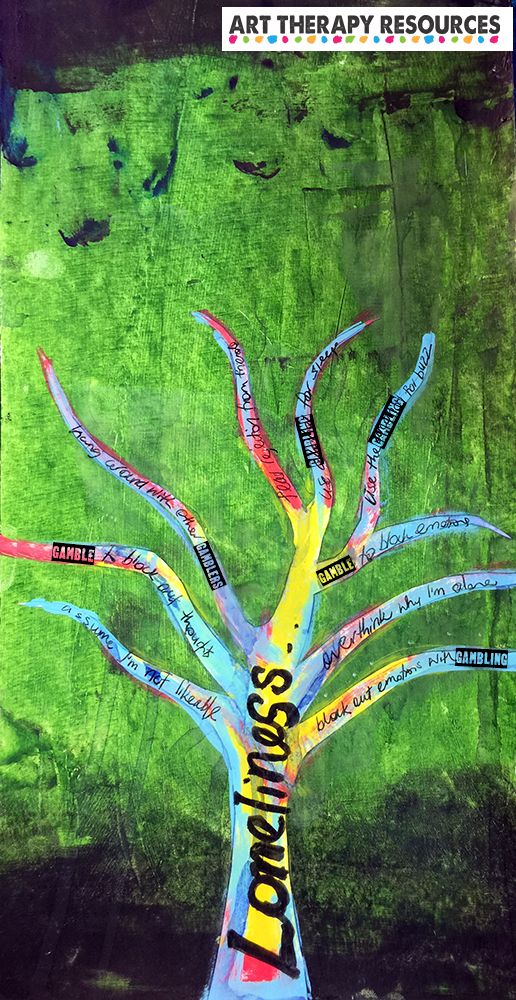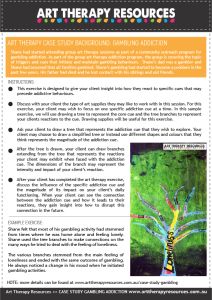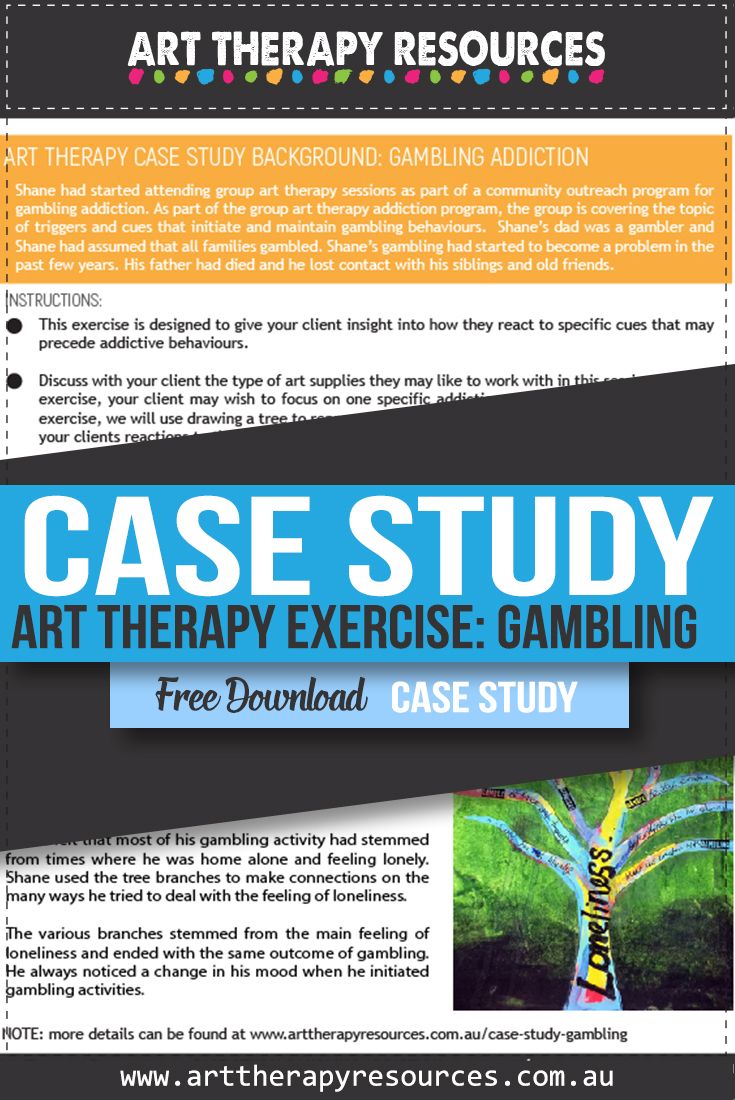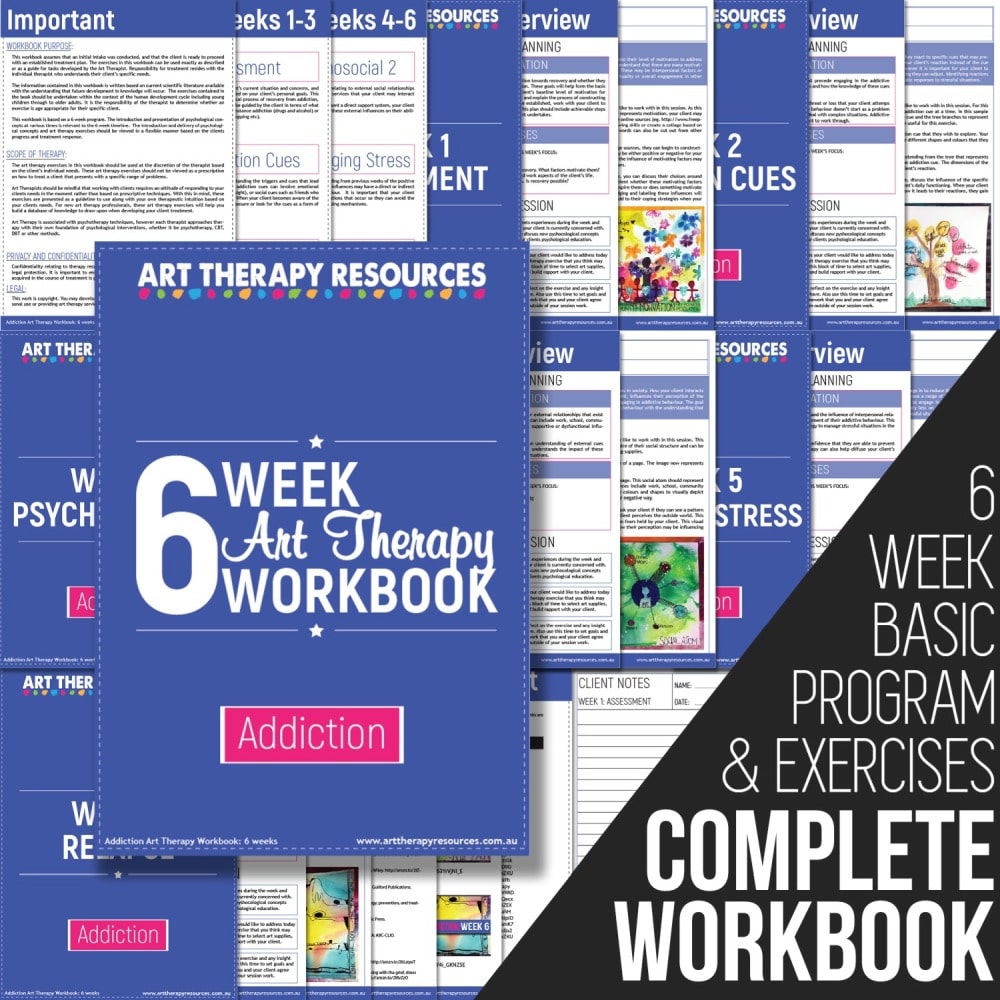THIS POST INCLUDES:
- Art Therapy and Gambling
- About the Client
- Current Client Issues
- Art Therapy Exercise
- Client Insight and Outcomes
- Disclaimer
- FREE DOWNLOAD Art Therapy Exercise
ART THERAPY AND GAMBLING
Under the DSM-5 diagnostic criteria, gambling problems may be classified under Section II Substance-related and Addictive Disorders as a non-substance disorder. As with most behaviour, there is often a continuum that identifies the severity and persistence of behaviour to determine if the behaviour is a temporary reaction to circumstances or learning, or alternatively, pervasive and severe in nature.
The DSM-5 (American Psychiatric Association, 2013) states that to meet the definition of a gambling disorder, the following applies:
Persistent and recurrent problematic gambling behavior leading to clinically significant impairment or distress, as indicated by the individual exhibiting four (or more) of the following in a 12-month period:
- Needs to gamble with increasing amounts of money in order to achieve the desired excitement.
- Is restless or irritable when attempting to cut down or stop gambling.
- Has made repeated unsuccessful efforts to control, cut back, or stop gambling.
- Is often preoccupied with gambling (e.g., having persistent thoughts of reliving past gambling experiences, handicapping or planning the next venture, thinking of ways to get money with which to gamble).
- Often gambles when feeling distressed (e.g., helpless, guilty, anxious, depressed).
- After losing money gambling, often returns another day to get even (“chasing” one’s losses).
- Lies to conceal the extent of involvement with gambling.
- Has jeopardized or lost a significant relationship, job, or educational or career opportunity because of gambling.
- Relies on others to provide money to relieve desperate financial situations caused by gambling.
The DSM-5 also states that the behaviour should be viewed through the lens of a possible manic episode before applying a gambling addiction criteria.
As with many addiction type issues, treatment can come in the form of addressing many issues that focus on:
- Motivation for change
- Behavioural change to addiction cues and triggers
- Managing stress
- Interpersonal relationships
- Coping strategies
- Relapse prevention
The loss of control over gambling behaviour often leads to a significant detrimental effect on an individual’s family, work, and social circles. This multi-factorial effect can impact a number of parties who may be confronted by the individual’s behaviour of lying, theft, and financial crisis.
Gambling has a strong reward component for individuals as they often seek to strengthen wins and compensate for any losses. The individual often becomes locked in a cycle of attempting to repeat past wins and rectify past losses.
Distortions in thinking is a strong factor in the development and maintenance of gambling addiction. Individuals are prone to align with superstitions, control over outcomes, and overconfidence of skills vs chance.
Emotions also factor in gambling activities as individuals will often gamble based on the high emotions of winning and appearing rich and impressive to people. Additionally, individuals experience the emotions of feeling helpless and guilty about losing gambling outcomes.
HOW ART THERAPY CAN HELP WITH GAMBLING ADDICTION
Addictions have a strong link to anxiety and therefore art therapy can benefit clients with addictions through the same art therapy techniques used for those experiencing anxiety.
Feelings of shame are prevalent in individuals who have addictions. This shame often stems from the outcomes of dysfunctional addictive behaviour which may include loss of a job, relationships, lying, theft, and devastating financial impact.
Art therapy can assist in exploring feelings of shame, however, discussing shameful feelings can be painful for individuals, so art therapy allows the individual to explore the feelings without needing to express the shame verbally. Verbal expression of shame can often be confronting which can result in the individual avoiding any discussion surrounding these feelings.
As the client progresses through reducing gambling behaviours and subsequent recovery, art therapy techniques can provide a self-control technique by disrupting maladaptive behaviour by the individual.
MOTIVATIONAL COMPONENT
It is important to explore a client’s motivation towards recovery and whether they have accepted their behavioural patterns indicate an addiction. You can work with your client to determine your client’s baseline level of motivation for recovery from addiction.
Furthermore, it’s important to discuss goal setting with your client and explain the process of constructing goals that are realistic, and measurable. Once the goals are established, you can work with your client to develop a plan that will help achieve the agreed goals. This plan should include achievable steps with a feedback mechanism to reflect on the steps that the client undertakes.
It is useful to work with your client to ascertain what factors may motivate them to engage in gambling behaviours as well as any factors that may motivate them to abstain from gambling behaviours.
BEHAVIOURAL INTERVENTIONS
An art therapist can work with a client to determine the foundations of understanding the behavioural component of gambling addiction. This includes:
- Understanding the triggers and cues that are linked to gambling
- Identifying the situations that are considered high-risk for gambling addiction
- Developing behavioral strategies to intervene the pull towards gambling behaviours
Art therapy is a creative space that helps explore and provide clients with insight into possible cues that precede engaging in gambling behaviour. Art therapists can help clients identify these cues and understand how the knowledge of these cues may influence their behaviour.
Specific situations and other sensory cues can often trigger a fear, threat or loss that your client may attempt to cope with through addictive behaviours. In many cases, often the gambling behaviour doesn’t start as a problem behaviour but instead starts as a solution by an individual to deal with complex situations. Addictive behaviour may have multiple triggers and cues that your client may need to explore.
COPING STRATEGIES
Once your client has explored possible addiction cues they have a better understanding of the development of their addictive behaviour. This understanding can assist your client in establishing a strategy to manage stressful situations in the future. Having a strategy in place can provide your client with confidence that they can prevent engaging in addictive behaviours in the future. Art Therapy can also help diffuse your client’s emotional state when stressful situations occur.
RELAPSE
Relapse is common when working through addiction recovery. Your client’s motivation and self-belief in their ability to recover is a strong influence on recovery. This also translates to your client’s expectation of the process of recovery from addiction, including accepting external support and engaging in positive interpersonal relationships.
An understanding of relapse should be included in the set of coping skills your client has available to them. As your client will have a set of coping skills for stressful events, they should also be provided with a strategy for relapse.
ABOUT THE CLIENT
- Name: Shane
- Age: 30
- Summary of sessions to date: Shane had started attending group art therapy sessions as part of a community outreach program for gambling addiction.
CURRENT CLIENT ISSUES
As part of the group art therapy addiction program, the group is covering the topic of triggers and cues that initiate and maintain gambling behaviours. Shane’s dad was a gambler and Shane had assumed that all families gambled. Shane’s gambling had started to become a problem in the past few years. His father had died and he lost contact with his siblings and old friends.
ART THERAPY EXERCISE
This exercise is designed to give your client insight into how they react to specific cues that may precede addictive behaviours. The focus of this exercise is on your client’s reaction instead of the cue itself.
External cues may influence addictive behaviour, however, it is important for your client to understand that regardless of the cue, their reaction is something they can adjust. Identifying reactions will provide insight into behaviours that may appear as automatic responses to stressful situations.
INSTRUCTIONS:
- Discuss with your client the type of art supplies they may like to work with in this session. For this exercise, your client may wish to focus on one specific addiction cue at a time. In this sample exercise, we will use drawing a tree to represent the core cue and the tree branches to represent your client’s reactions to the cue. Drawing supplies will be useful for this exercise.
- Ask your client to draw a tree that represents the addiction cue that they wish to explore. Your client may choose to draw a simplified tree or instead use different shapes and colours that they think represents the magnitude of the addiction cue.
- After the tree is drawn, your client can draw branches extending from the tree that represents the reactions your client may exhibit when faced with the addiction cue. The dimensions of the branch may represent the intensity and impact of your client’s reaction.
- After your client has completed the art therapy exercise, discuss the influence of the specific addiction cue and the magnitude of its impact on your client’s daily functioning. When your client can see the connection between the addiction cue and how it leads to their reactions, they gain insight into how to disrupt this connection in the future.
CLIENT INSIGHT AND OUTCOMES
Shane felt that most of his gambling activity had stemmed from times where he was home alone and feeling lonely. He used the tree branches to make connections on the many ways he tried to deal with the feeling of loneliness. The various branches stemmed from the main feeling of loneliness and ended with the same outcome of gambling. He always noticed a change in his mood when he initiated gambling activities.

For additional resources:
This workbook was created for art therapists who work with clients dealing with addiction. The workbook covers information for both substance and behavioural addictions.
If your client work involves helping people battling addiction, this art therapy workbook provides a recovery program to help your client beat their addiction.
The 6 week Art Therapy Addiction Workbook outlines a recovery program delivered over 6 weeks. The workbook models the typical recovery pathway for a client with addiction. Each week provides information in a simple and concise format. The workbook details the focus points of the pathway as well as an outline of the relevant psychoeducation to provide your client.
Each week you are provided with a suggested list of art therapy exercises to use with your client. The workbook also includes a more detailed instruction guide for one art therapy exercise. This exercise includes access to video content showing the art therapy exercise being created.
This workbook is direct and easy to understand. The materials presented in the workbook are written based on current scientific literature available. The workbook materials are created based on a variety of psychological approaches including CBT, ACT, DBT, behavioural modification, and general psychotherapy principles.
Included in the book is a comprehensive reference list of 18 publications that were used to form the content of this workbook.
To get the most out of this workbook we strongly recommend that you use the goal setting themes provided over the 6 weeks. The topics will help assess your client’s motivation toward addiction recovery. Your client will also work through themes surrounding addiction cues, managing stress, and relapse. Your client will be able to determine the behavioural context of their addiction and utilise important coping strategies to help with emotional regulation.
The contents of this workbook include:
Important information for the Art Therapist
- Workbook Purpose
- Scope of Therapy
- Privacy and Confidentiality
- Legal
Snapshots Weeks 1-6
GOAL: Assessment
GOAL: Addiction Cues
GOAL: Psychosocial 1
GOAL: Psychosocial 2
GOAL: Managing Stress
GOAL: Relapse
WEEK 1 ASSESSMENT
- Pre-session Planning
- Psychoeducation
- Art Exercises
- During the Session
- Art Therapy Exercise
- Summary
- Instructions
- Client Reflections
- Client Image
- Video of art therapy exercise
WEEK 2 ADDICTION CUES
- Pre-session Planning
- Psychoeducation
- Art Exercises
- During the Session
- Art Therapy Exercise
- Summary
- Instructions
- Client Reflections
- Client Image
- Video of art therapy exercise
WEEK 3 PSYCHOSOCIAL 1
- Pre-session Planning
- Psychoeducation
- Art Exercises
- During the Session
- Art Therapy Exercise
- Summary
- Instructions
- Client Reflections
- Client Image
- Video of art therapy exercise
WEEK 4 PSYCHOSOCIAL 2
- Pre-session Planning
- Psychoeducation
- Art Exercises
- During the Session
- Art Therapy Exercise
- Summary
- Instructions
- Client Reflections
- Client Image
- Video of art therapy exercise
WEEK 5 MANAGING STRESS
- Pre-session Planning
- Psychoeducation
- Art Exercises
- During the Session
- Art Therapy Exercise
- Summary
- Instructions
- Client Reflections
- Client Image
- Video of art therapy exercise
WEEK 6 RELAPSE
- Pre-session Planning
- Psychoeducation
- Art Exercises
- During the Session
- Art Therapy Exercise
- Summary
- Instructions
- Client Reflections
- Client Image
- Video of art therapy exercise
Client Notes Template for each week + Blank Bonus Worksheet
Reference Materials List
DISCLAIMER
This case study represents a snapshot of the client’s progress in treatment. The exercise in this article could be used as written or as a guide for new and original tasks developed by the Art Therapist. Responsibility for treatment resides with the individual therapist who understands their clients specific needs. The art therapy exercise should not be viewed as a pre-defined directive on how to treat a client that presents with a specific range of problems.This art therapy exercise will help build a database of knowledge to draw upon when helping your client. Art Therapy is associated with psychotherapy techniques, however each therapist often approaches therapy with their own foundation of psychological interventions, whether it be psychotherapy, CBT, DBT or other methods.
FREE DOWNLOAD: Art Therapy Exercise
Download the FREE Art Therapy Exercise based on the above Case Study. The free download includes instructions for the art therapy exercise, along with an example of the art therapy exercise.

BUILD YOUR ART THERAPY REFERENCE MATERIALS:
Pin this image to your Pinterest board.

SHARE KNOWLEDGE & PASS IT ON:
If you’ve enjoyed this post, please share it on Facebook, Twitter, Pinterest. Thank you!

